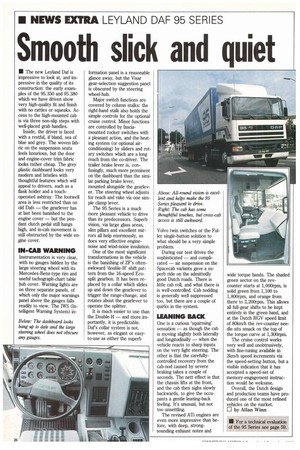Smooth slick and quiet
Page 28

If you've noticed an error in this article please click here to report it so we can fix it.
• The new Leyland Daf is impressive to look at, and impressive in the quality of its construction: the early examples of the 95.350 and 95.380 which we have driven show very high-quality fit and finish with no rattles or squeaks. Access to the high-mounted cab is via three non-slip steps with well-placed grab handles.
Inside, the driver is faced with a restful, if bland, sea of blue and grey. The woven fabric on the suspension seats feels luxurious, but the door and engine-cover trim fabric looks rather cheap. The grey plastic dashboard looks very modern and bristles with thoughtful features which will appeal to drivers, such as a flask holder and a touchoperated ashtray. The footwell area is less restricted than on old Dafs — the gearlever has at last been banished to the engine cover — but the pendant clutch pedal still hangs high, and in-cab movement is still obstructed by the wide engine cover.
IN-CAB WARNING
Instrumentation is very clear, with no gauges hidden by the large steering wheel with its Mercedes-Benz-type rim and useful tachograph-chart table hub cover. Warning lights are on three separate panels, of which only the major warnings panel above the gauges falls readily to view. The IWS (Intelligent Warning System) in formation panel is a reasonable glance away, but the Visar gear-selection suggestion panel is obscured by the steering wheel-hub.
Major switch functions are covered by column stalks: the right-hand stalk also holds the simple controls for the optional cruise control. Minor functions are controlled by fasciamounted rocker switches with a pleasant action, and the heating system (or optional airconditioning) by sliders and rotary switches which are a long reach from the co-driver. The trailer brake lever is, confusingly, much more prominent on the dashboard than the similar parking brake lever, mounted alongside the gearlever. The steering wheel adjusts for reach and rake via one simple clamp lever.
The 95 Series is a much more pleasant vehicle to drive than its predecessors. Superb vision, via large glass areas, slim pillars and excellent mirrors all help enormously, as does very effective enginenoise and wind-noise insulation.
One of the most significant transformations in the vehicle is the banishing of ZF's oftenawkward 'double-H' shift pattern from the 16-speed Ecosplit gearbox. It has been replaced by a collar which slides up and down the gearlever to trigger the range-change, and rotates about the gearlever to operate the splitter.
It is much easier to use than the Double-H — and more importantly, it is predictable. Dafs collar system is not, however, as elegant or easyto-use as either the superb Volvo twin switches or the Fuller single-button solution to what should be a very simple problem.
During our test drives the sophisticated — and complicated — air suspension on the Spacecab variants gave a superb ride on the admittedly good Dutch roads. There is little cab roll, and what there is is well-controlled. Cab nodding is generally well suppressed too, but there are a couple of quirks in the system.
LEANING BACK
One is a curious 'squirming' sensation — as though the cab is moving slightly both laterally and longitudinally — when the vehicle reacts to sharp inputs on the very light steering. The other is that the carefullycontrolled recovery from the cab-nod caused by severe braking takes a couple of seconds. The nett effect is that the chassis lifts at the front, and the cab then sighs slowly backwards, to give the occupants a gentle leaning-back feeling. It's unusual, but not too unsettling.
The revised ATi engines are even more impressive than before, with deep, strongsounding exhaust notes and wide torque bands. The shaded green sector on the revcounter starts at 1,000rpm, is solid green from 1,100 to 1,800rpm, and orange from there to 2,200rpm. This allows all full-gear shifts to be kept entirely in the green band, and at the Dutch HGV speed limit of 80km/h the rev-counter needle sits smack on the top of the torque curve at 1,300rpm.
The cruise control works very well and unobtrusively, with fine-tuning available in 2krri/ti speed increments via the speed-setting button, but a visible indication that it has accepted a speed-set of memory-engagement instruction would be welcome.
Overall, the Dutch design and production teams have produced one of the most refined vehicles on the market. 0 by Allan Winn




























































































